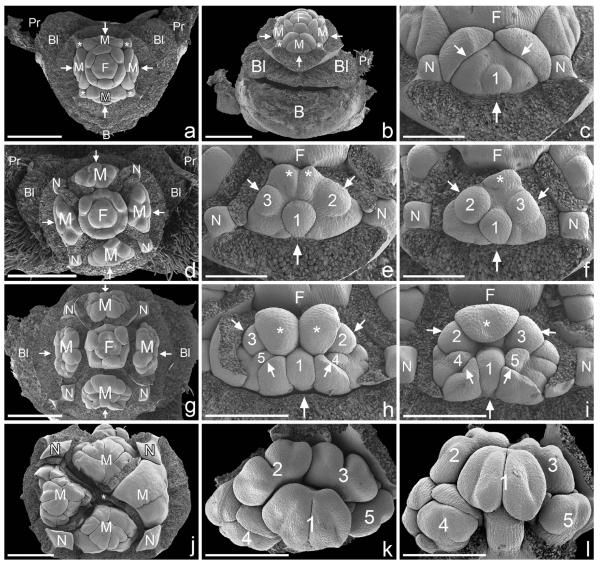Fig. 3.
Calycopeplus paucifolius, pseudanthium development (scanning electron micrographs). (a) Young pseudanthium (frontal view) in the axil of a bract and preceded by lateral prophylls and bracteoles (removed). Four male partial inflorescences (two in transversal and two in median position) surrounding central female flower. Each of the male partial inflorescences is subtended by a bract (arrow, bract removed) and flanked by nectaries (asterisks). (b) Abaxial view of (a), showing the massive bract and lateral bracteoles (removed). (c) Abaxial male partial inflorescence flanked by two nectaries. The bract of the male partial inflorescences also becomes the bract of the first-formed male flower (1). Two lateral phyllomes will become the bracts of two lateral flowers (see e, f ). (d) Similar to (a), but with central female flower somewhat younger (see Fig. 4 for details) and male partial inflorescences somewhat older. (e) Right male partial inflorescence of (d), flanked by two nectaries. Three male flowers (1–3), of which each is subtended by a bract (arrows; bracts removed). Two adaxial organs arise (asterisks). (f) Abaxial male partial inflorescence, similar to (e) but with only one adaxial organ (asterisk). (g) Somewhat older pseudanthium, overview. (h) Abaxial male partial inflorescence of (g). Adaxial bracts enlarged and appear to be ‘empty’ bracts (asterisks) that do not subtend further male flowers. Two more male flowers are formed in abaxial position (4, 5). (i) Adaxial male partial inflorescence of (g). Only one adaxial bract is formed (asterisk). Male flowers still undifferentiated. (j) Pseudanthium with distinctly enlarged nectaries and male partial inflorescences which cover the reduced(?) female flower in the centre (asterisk). Male bracts removed in all but the right male partial inflorescence. (k) Male partial inflorescence (frontal view) with five male flowers, of which the first three already show distinct anthers. (l) Tilted side view of (k), showing the central male flower (1) without constriction, and two lateral male flowers (4, 5) in which anther formation starts. Arrows in (a–i) denote bracts and point from the bract towards the structure which they are subtending; B, bract; Bl, bracteole; F, female flower; M, male partial inflorescence; N, nectary; Pr, prophyll. Scale bars = 500 μm (a, b, d, g, j), 200 μm (c, e, f) and 300 μm (h, i, k, l).

